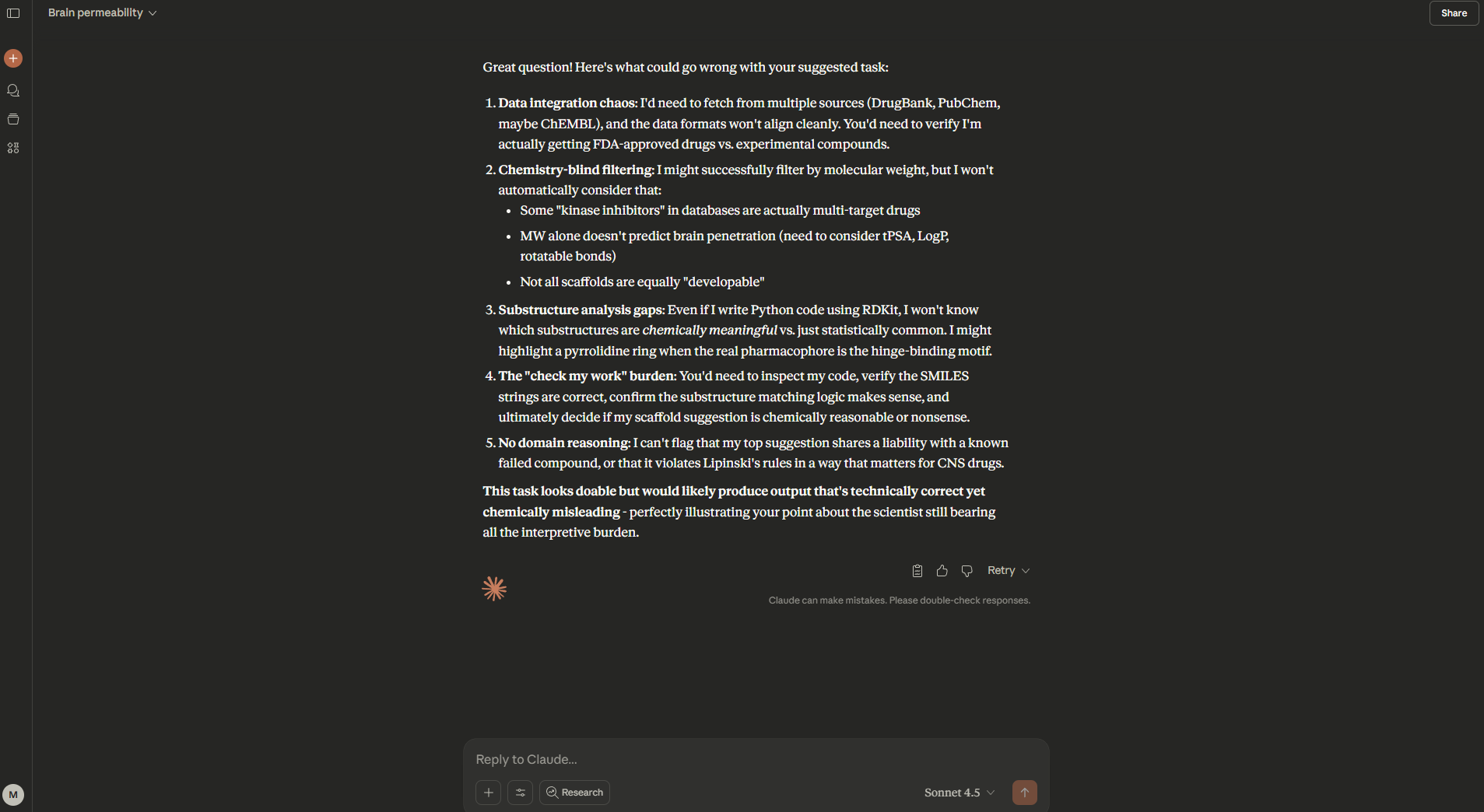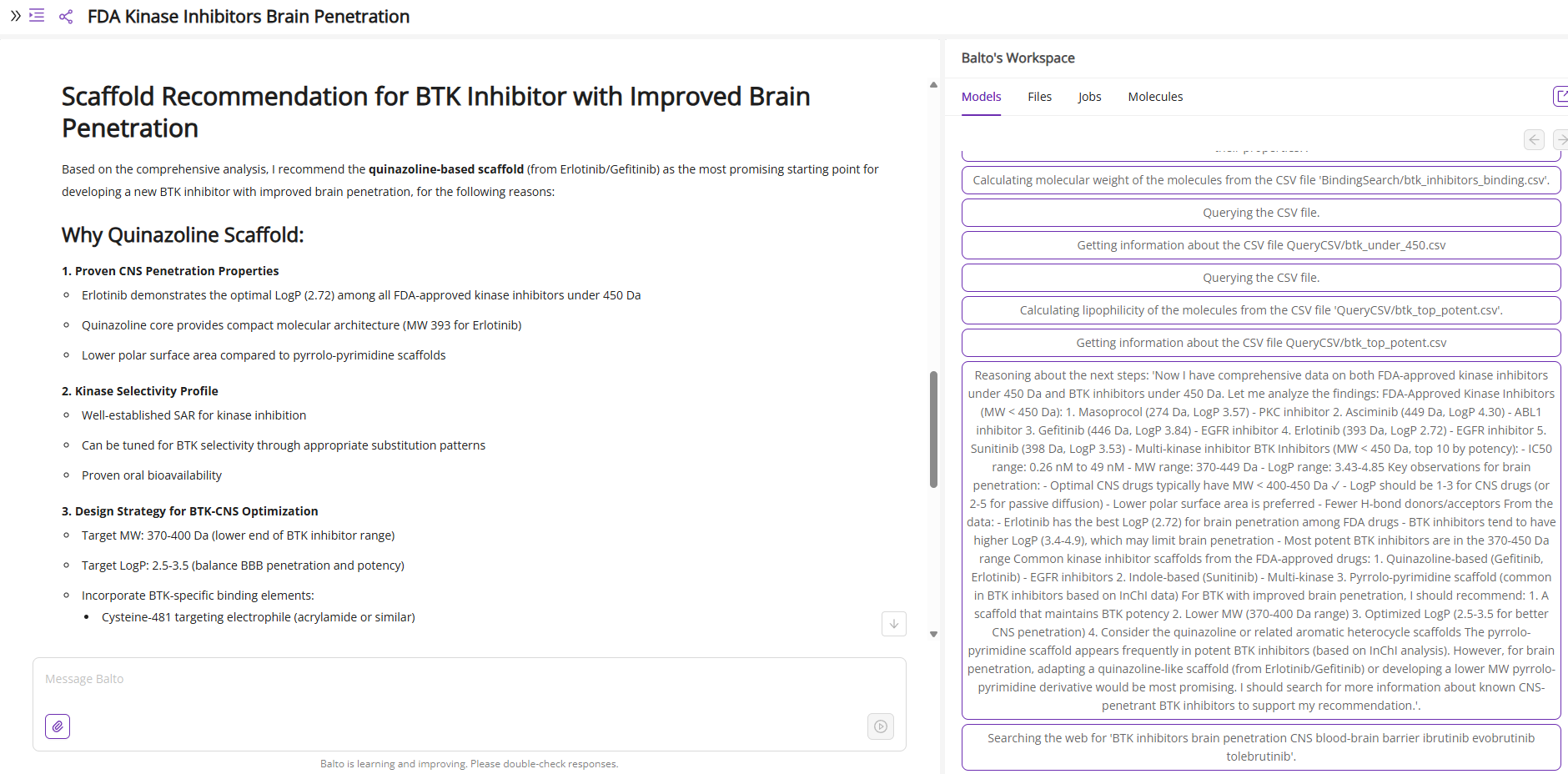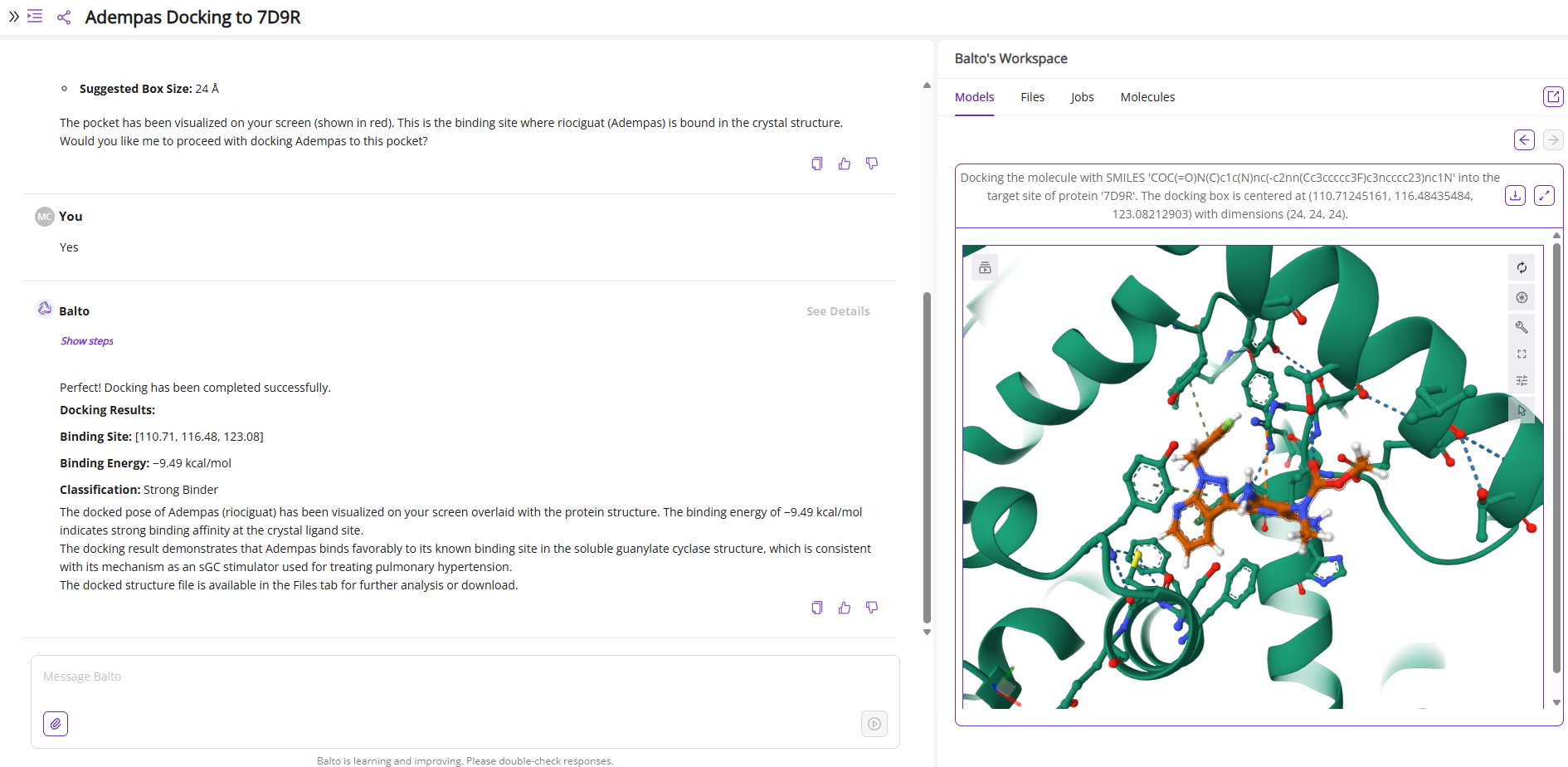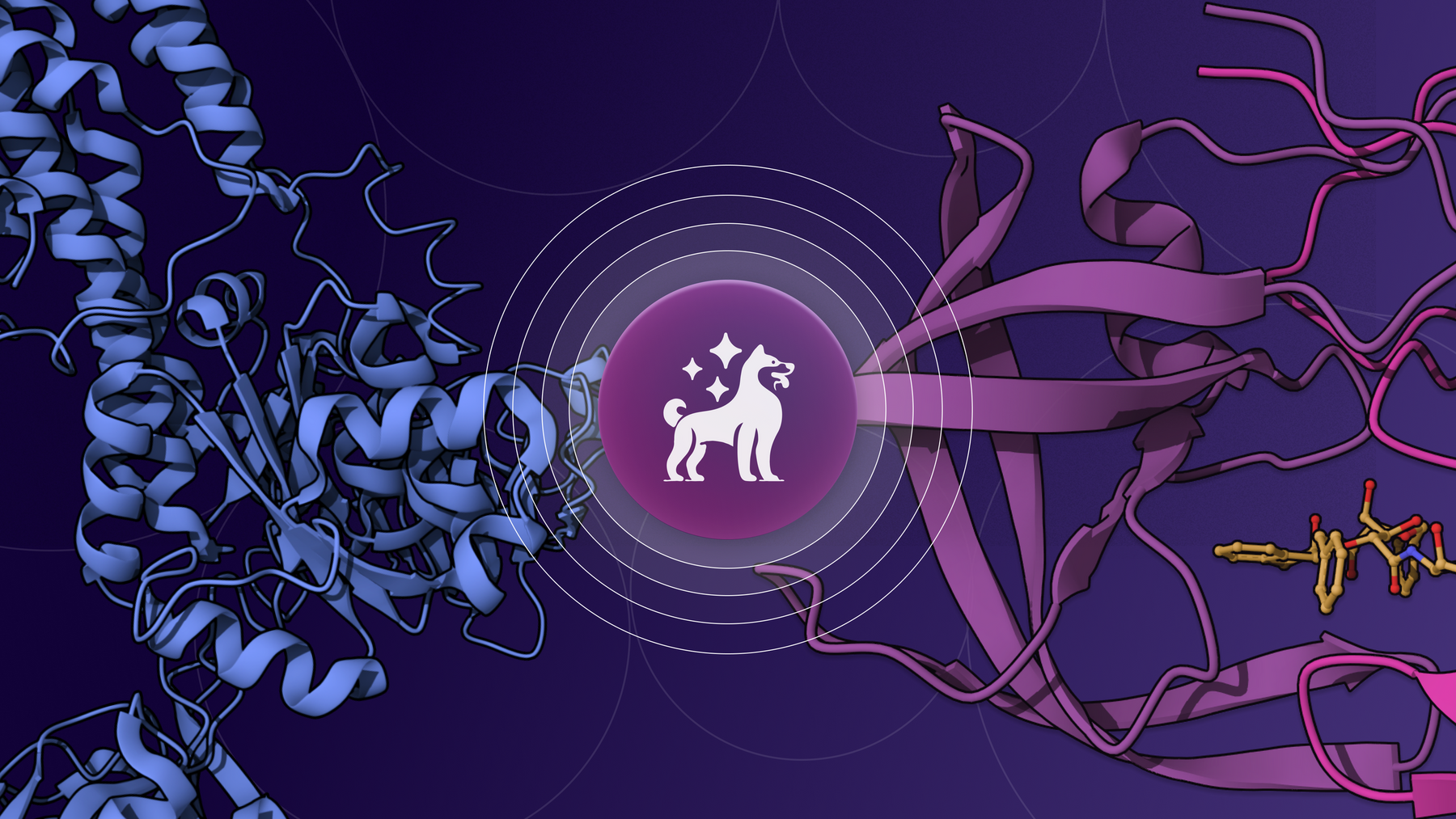AI in science is crossing a threshold. With the launch of tools like Claude for Life Sciences, the notion that assistants should do more than generate text is going mainstream— AI in research today needs to use scientific tools, interact with real data, and help move projects forward. Tool-use isn’t a novelty anymore; it’s quickly becoming the baseline.
But an important distinction is emerging: different scientific domains need different assistants.
Claude is becoming a strong partner for biology-forward workflows—protocol drafting, bioinformatics, regulatory documentation, and connecting to platforms like Benchling or PubMed.
Medicinal chemistry is a different problem space.
It doesn’t live in documents. It lives in structures, pockets, properties, conformers, and models that compute. That’s why general assistants (Claude, ChatGPT, Gemini) are still limited to reading and summarizing (or in the case of Claude for Life Science, passing text-based data between tools).
Balto is built for chemistry.
It’s the domain-specific, tool-using assistant for molecular design, docking, property prediction, and structural analysis—the “Claude for chemistry,” powered not by document connectors but by molecular simulations.
This post walks through what current generative AI can (and can’t) do for chemists, and where chemistry-aware assistants like Balto meaningfully change the workflow—from reading to extracting, modeling, interpreting, and deciding.
Generative AI for Reading and Knowledge Synthesis in Chemistry
General-purpose AI excels at summarizing. Models like Claude or ChatGPT are excellent at summarizing biological literature or protocols, and Claude’s new scientific connectors broaden that even further. But none of these tools can extract structures from PDFs and convert them to usable chemical objects—something that matters the moment your work depends on molecules rather than prose.
While general summarization is quite strong from these models, there are limits - particularly when it comes to queries where an accurate answer comes from gathering and manipulating the right set of underlying data. These models aren’t built for chemistry. They won’t flag the difference between a small mistake and a major flaw in a synthesis route. They also can’t pull chemical structures out of a PDF and turn them into something you can actually work with. So while they help with surface-level understanding, they stop short of giving you material you can use in the lab.

So how does a chemistry-specific genAI tool differ when it comes to reading and knowledge synthesis?
Instead of just saying what a paper is about, the right tool can pull out molecules, convert them to SMILES, and connect them to modeling or docking. That means the jump from “reading” to “doing” is immediate. Additionally, parts of data curation and knowledge gathering that require "action" can occur directly within a single chat and interface.

Reading and Knowledge Synthesis: General vs. Chemistry-specific
Integrating Tools and Agentic Workflows in GenAI for Chemistry
Some AI tools can now connect to external apps or even run short workflows on their own. Coding copilots like GitHub Copilot or ChatGPT with a Python sandbox can fetch data, clean it up, and run analyses. More advanced “agentic” setups can chain multiple steps together without constant prompting and are often paired with tool use.
Claude’s new scientific connectors—Benchling, BioRender, PubMed, and others—push this further for biology and document-heavy scientific research. They make it easier to coordinate literature, protocols, and experimental records through a single interface.
But chemistry needs something different. Chemists don’t just move text between systems; they move structures, 3D pockets, ADMET properties, and docking inputs. Those require tools that understand molecules, not just metadata. That’s why Balto bundles chemistry-specific capabilities directly into chat, no scripting or custom setup required.
In theory, you could ask a general agent to pull data from PubChem, write Python to filter results, and generate plots. But here’s the catch: most of us aren’t software engineers. Catching subtle errors or debugging generated code takes time and expertise—and even skilled coders end up validating every step. Worse, these systems aren’t tuned for chemistry, so they won’t know what filters matter in a lead optimization project or how to flag a result that looks chemically off.

So while agentic workflows and coding copilots are a big step forward, they still keep the burden on the scientist. You’re the one who has to check outputs, fix scripts, and connect the dots.

Integrating Tools with GenAI: General vs. Chemistry-Specific
Running Simulations
This is where general-purpose genAI stops. ChatGPT or Claude can explain what a molecular docking experiment is. They can even write example code for it. But no "out -of-the-box" model is set up to actually run the simulation. At best, you get instructions for tools you’ll have to set up and run yourself.
A chemistry-specific AI assistant changes that. Instead of telling you how to run a simulation, it runs it for you. Docking, pocket finding, ADMET prediction—these are built into the system. You ask in plain language, and the assistant produces usable results.

That’s the difference between an AI that only talks about science and one that can do science. For a medicinal chemist, it means going straight from idea to data in the same tab without writing code.
Running Molecular Simulations: General vs. Chemistry-Specific
Interpreting Results
Analyzing outputs is just as important as running the job. General AI models can summarize results, but they don’t know enough chemistry to judge them correctly. They might overstate an outcome, misinterpret a graph, or simply make something up. This is the risk of hallucination — the model fills in blanks with guesses.
A chemistry-specific AI assistant is tuned differently. It doesn’t just summarize data; it can interpret it with the rules and context of the field. For example, it can highlight whether a docking score is within a realistic range, flag odd results, or point out if a conformer looks unstable. Instead of acting like a general storyteller, it behaves more like a trained colleague who knows what “normal” looks like in medicinal chemistry. Additionally, domain-specific visualizations are the bread and butter of informed decision making and collaboration in life science research. These domain-specific visualizations are yet to be included in common LLMs.

Interpreting Scientific Results: General vs. Chemistry-Specific
Benchmarks: Scientific Comprehension to Help You Do Work
A chemistry-aware assistant isn’t just about running simulations—it’s about understanding scientific material well enough to guide decisions. To measure this, we evaluated Balto on LitQA2 (Future House), a benchmark designed to test deep reading comprehension of real scientific papers.
Balto’s LitQA2 score: 86% pass rate (172/200)
- PaperQA2 (Future House): 66.0% ± 1.2
- Human experts: 67.7% ± 11.9
- Typical LLM performance without tool use: ~25–30%
This means Balto reads and reasons about chemical literature at a level that exceeds reported human expert performance and surpasses existing published benchmarks—not because it is a general LLM, but because it is tuned specifically for chemistry and built to work with chemical structures and data.
.png)
This level of comprehension is what makes the next step possible: an assistant that not only understands your work, but can help do the work.
Acting Like a Lab Assistant
Most AI tools today stop at talking. They read, they summarize, they even suggest code. But they don’t plan an experiment with you. And they don’t carry out the steps.
A chemistry-specific AI assistant shifts from being a “chatbot” to being a lab assistant. It can plan workflows: suggest which molecules to test, flag where to focus next, and lay out the steps in order. And it doesn’t stop there — it can also do the work: extract molecules, run docking, generate conformers, and return results you can use.
This combination of planning and doing is what makes the difference. Instead of a tool that just answers questions, you have one that helps push projects forward. Then the question becomes how well that assistant provides work that is accurate, fast, and understandable. We think this is where Balto really shines.
👉 With Balto, you can:
- Pull a compound from popular databases and run it through a docking workflow in one chat.
- Ask for binding pockets on a target and get structured results back.
- Move from idea to data without switching tools or writing code.
Additionally, the combination of access to underlying chemistry tools and
Acting Like a Lab Assistant: General vs. Chemistry-Specific
Different assistants for different domains
The launch of Claude for Life Sciences has recently garnered a great deal of attention: it underlines the new-ish expecatation that genAI is moving beyond chat into action, with connectors and skills that make it genuinely useful for biologists, clinical teams, and regulatory scientists.
But it also reinforces a crucial reality:
Life sciences is not one domain.
Cheminformatics and molecular modeling have different needs than genomics or regulatory writing. No single assistant will do everything well.
Claude is built for biology-heavy workflows:
- literature reviews
- protocol and SOP generation
- bioinformatics and data analysis via connectors
- clinical and regulatory documentation
- access to Benchling, BioRender, PubMed, Wiley, and 10x tools
Balto is built for chemistry-heavy workflows:
- pull molecular data from common databases
- generating SMILES or 3D structures instantly
- running docking and pocket finding in-chat
- property prediction and ADMET
- visualizing chemical results
- going from idea → molecule → simulation without code
If you’re a chemist, Balto is the assistant designed for your domain—the one that understands your molecules, your tools, and your workflows.
👉 Try Balto and see how domain-specific simulation-powered AI changes the pace of medicinal chemistry.






.png)

.png)


.png)


.png)

.png)





.png)



.png)
.png)


.png)

.png)
